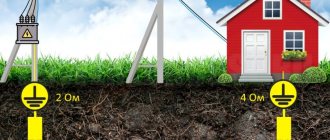Electrical sockets are accessories familiar to potential users. They are used everywhere: at home, at work, in public places, etc. According to technical standards, sockets must be grounded - this will protect households from electric shock when electrical appliances break down.
However, you must admit that it is unlikely that any consumer can say with confidence that all sockets in a house or apartment are grounded. To find out the location of the wires in the electrical wiring, it is necessary to carry out a number of tests.
We will tell you how to check the grounding in an outlet in various ways - by external signs and using special tools.
What is grounding and why is it necessary?
Grounding refers to the connection of the electrical system of a house or apartment with a grounding conductor that is in constant contact with the ground. Due to it, dangerous current is removed from its elements, for example, metal cases and frames of various electrical equipment.
Grounding must be done in order to protect the user from electric shock when household appliances malfunction or accidentally touch bare wires, as well as to ensure the safe and correct operation of the devices themselves.
Most cases of electric shock occur due to the simultaneous contact of an electrical appliance with damaged insulation and a conductive metal object: a radiator, water pipe, etc.
Installation tools
During the installation process, you will need high-quality tools and materials. It is necessary to prepare pliers, wire cutters (side cutters), a regular and indicator screwdriver with well-insulated handles.
Wago clamp-type terminal connectors are optimally suited for interwire connections. Standard plastic screw terminal blocks will cost a little less.
A roll of insulating tape will probably come in handy. To strip the cores from the insulation, it is better to purchase a specialized device - a stripper.
What household appliances need to be grounded?
The metal casing of any ungrounded electrical appliance is potentially dangerous. Therefore, it is necessary to ground all electrical appliances in the house with a conductive housing that have protection class I. These include personal computers, boilers, refrigerators, dishwashers and washing machines and other powerful household appliances.
Particular attention should be paid to grounding loads such as boilers, washing machines and dishwashers that have direct contact with water. Water is a dielectric, but due to impurities it still conducts electricity well.
For example, if there is a water leak in a boiler (without a built-in RCD), voltage may appear on its body, and if it comes into contact with it, the user will receive an electric shock. When a washing machine is running in a damp room, the body may also be energized, even if the device is in full working order, provided that the water still “reaches” the voltage source - sockets or non-insulated terminal contacts inside the device.
The hob will also be more likely to leak current. Problems with this device may arise if its body is metal, the phase wire is broken and touches the body, and there is no grounding.
When installing plumbing or underfloor heating in a house due to faulty cable insulation, users are likely to receive an electric shock in places where water is spilled. It will be very risky to be in rooms with high humidity without grounding electrical appliances, for example, in baths and saunas.
Note!
Household appliances whose housing is made of non-conductive materials (protection class II), for example, vacuum cleaners, hair dryers and power tools, do not need to be grounded and can be connected to any outlet.
Therefore, the grounding system for household appliances must be included in the electrical wiring of any private house or apartment.
Precautionary measures
When connecting LED lamps yourself, you should take basic precautions. The basic safety rule is to carry out work only after turning off the power supply to the premises. To do this, you need to turn off the corresponding “machine” in the electrical panel.
Before starting installation, be sure to check that there is no 220V voltage on the wires using a special indicator. For greater safety, use dielectric rubber gloves. If an external inspection reveals a mechanical defect in the lighting device, then you should not use it due to a possible breakdown of the electrical insulation.
It is better to carry out work at heights with the help of a strong stepladder, rather than a dubious chair/stool with wobbly legs.
After completing the installation operations, we recommend checking the correctness of the implemented circuit and the reliability of all connections. Incorrect connections lead to a short circuit in the electrical network. Therefore, attention and attention again!
Grounding schemes
Currently, several wiring systems are used in the domestic sector, which differ in the types of wires entering the home and the location of the grounding elements. When installing grounding inside a house or apartment, it is important to know what kind of wiring system is used on the line.
| Grounding system | Short description |
| TN-C system | The neutral protective and neutral working conductors are combined into one wire along the entire section of the network from the transformer to the house. A phase (phase) and a combined conductor (PEN - protective neutral and working) enter the home. The system is found in old apartment buildings and is considered the most unreliable type due to the fact that if the PEN wire breaks, the protection is completely lost, and dangerous voltage may appear on the housing of household appliances. |
| TN-S system | The neutral protective and neutral working conductors run along separate wires throughout the entire section of the network from the transformer to the house. Phase(s), earth and zero enter the home. This type has a high level of safety because it eliminates the appearance of dangerous voltage on the load housings if the wire insulation is damaged. |
| TN-CS system | The neutral protective and neutral working conductors are combined into one wire only in a certain part of the network (usually, which goes from the transformer to the building). At the entrance to the home they are separated. The system has a drawback: if the combined PEN conductor on the line is damaged, life-threatening voltage will arise on all housings of household appliances in the house connected to the PE conductor. Therefore, it will be necessary to re-ground the PEN conductor with its own circuit before entering the building. |
| TT system | In this case, only the phase (phase) and neutral wires are supplied to the home. The PE conductor enters the object from its own ground loop. This option is actively used in country houses and cottages. |
Types of electrical outlets
The industry produces two types of products:
- equipped with a grounding bus;
- not having a grounding bus.
The first type of design is often called a “euro-socket”. This design fully satisfies electrical safety requirements. When changing electrical wiring, it is recommended to install sockets with grounding.
The appearance of the electrical outlet according to the standards established by the European Union countries. A distinctive feature of the design is the presence of contact bimetallic grounding plates
The second type of product is considered an outdated modification, but is still found in practice. Especially many outdated sockets are used in old buildings.
Design option without specific country affiliation. For modern electricians, it is considered an outdated model, which is not recommended for installation due to increased danger due to the lack of a grounding contactor
Both types of products are made for indoor or outdoor installation. According to the new PEB recommendations, modifications of sockets for internal installation must have bimetallic plates with a grounding contactor as part of the design.
For electrical sockets for external installation, the recommendations are the same, but in some cases of their use a two-wire interface is allowed.
Connecting grounding to electrical appliances
To ground household appliances (provided that there is an external grounding loop), you will need a cable with three wires marked in different colors (neutral - blue (N), phase - brown (or white, black, the color of the phase as a whole is not standardized) (L) and grounding (PE) – yellow-green). These wires are pulled from the electrical panel to three-pin sockets or directly to electrical appliances. In this case, the grounding wire is attached to the corresponding busbar in the panel.
In a private house, depending on the grounding system, the electrical network, as a rule, has its own external ground loop - a device consisting of a group of electrodes connected to each other and mounted around the building along its contour. If there is no such circuit, then it is necessary to invite specialists to install it.
Note!
Self-installation of an external ground loop requires knowledge of the principles of its design and manufacturing rules. In addition, there may be hidden objects underground (sewerage, electrical cables, gas pipelines), which can be accidentally damaged when installing the ground loop. Therefore, if you do not have the information, it is better to entrust this work to professionals!
As mentioned above, all modern electrical appliances of protection class I, in which a breakdown of current to the outer part of the housing is possible (for example, water heaters, electric stoves, ovens and washing machines) have Euro plugs with a grounding contact, which must be connected to a three-pin socket. If the wire needs to be connected directly to the device from the electrical panel, for example, to a voltage stabilizer or UPS, then for this purpose a special block with a grounding terminal is provided on their body.
Manufacturers of household appliances assume that users will connect their products, which have three-pin Euro plugs, to a three-wire network. However, today in our country, in many houses and summer cottages there are systems with two-wire networks. What to do in such cases?
In such cases, to create a reliable protective system, for example, in a country house, it is better to install your own grounding loop and lay a separate PE grounding wire in the premises and then connect it to sockets and the load.
If there is no grounding terminal in an apartment building, independent installation of the circuit is not allowed, since, as a rule, there will be a large number of communications in the ground next to the building.
Some users believe that they can do without grounding and simply install an RCD. However, although the protective device will help combat leakage currents, it will not be able to provide complete protection of electrical appliances throughout the house.
Note!
Installation of an RCD is necessary in any case, even if the house has a grounding system. All powerful electrical equipment must be connected via an RCD.
Using a tester or multimeter
Using a multimeter, you can try to determine the voltage passing between the conductor and the water supply or heating pipes. However, there will not be a 100% correct result. Often, the voltage between the phase and the water supply or heating system is equal to 220 V (in any case, the voltage should be higher than its value between the heating pipe and zero). But your measurements can be disrupted, for example, by a neighbor who “rewinds” electricity by choosing a heating pipe as grounding.
Of course, the best device for determining the phase is a screwdriver, which is combined with an indicator. I would like to believe that any owner who has a multimeter probably also has an indicator.
If you use a multimeter to determine the assignment of the conductors in a three-wire phase, it can show the voltage between the phase and one of the two remaining wires. Having thus learned the phase, you can use the above method and determine the protective zero and the working zero. We are talking about disconnecting one of the zeros and determining their purpose using a lamp in the socket.
Do voltage stabilizers and UPSs need to be grounded?
When creating a system of high-quality and uninterrupted power supply for household electrical appliances, it is important to remember that voltage stabilizers and UPSs, like other Class I electrical appliances, require grounding, such as this:
- will protect the user from electric shock upon contact with the metal casing of the stabilizer/UPS and equipment powered from it;
- will protect against leakage currents coming from the stabilizer network filters (they can leak to grounding).
Helpful information
Grounding lamps, like supports, is one of the stages of installing outdoor lighting. Installation of grounding is the most important and mandatory stage in the installation of an external lighting system. The installation of this system itself has several stages.
Note! In order to properly ground the lamps to the support structure, it is necessary to strictly adhere to the rules and regulations that are prescribed in the PUE. This will avoid breakdown in the insulation of the power cable and prevent electrical injury.
Outdoor lighting installation
According to established instructions developed for the arrangement of grounding networks, all metal supports, without exception, that are elements of an external lighting system are subject to mandatory grounding. The principle of grounding is that if there is a violation of the insulation of the electrical wiring of the lamps, the electric current begins to flow into the ground. As a result, a voltage distribution will occur in the area where the electric current spreads, which will become harmless to humans. The voltage distribution depends on the resistivity of the soil, as well as the placement of ground electrodes on the supports of the street lighting system.
Watch the video
Sources
- https://FishkiElektrika.ru/kak-proverit-est-zazemlenie-v-rozetke-ili-net
- https://220.guru/electroprovodka/rozetki-vyklyuchateli/kak-proverit-zemlyu-v-rozetke.html
- https://samelectrik.ru/kak-uznat-est-zazemlenie-v-rozetke-ili-net.html
- https://samstroy.com/%D0%BA%D0%B0%D0%BA-%D0%BF%D1%80%D0%BE%D0%B2%D0%B5%D1%80%D0%B8% D1%82%D1%8C-%D0%B7%D0%B0%D0%B7%D0%B5%D0%BC%D0%BB%D0%B5%D0%BD%D0%B8%D0%B5-% D0%B2-%D1%80%D0%BE%D0%B7%D0%B5%D1%82%D0%BA%D0%B5-%D0%B4%D0%BB/
- https://vseobelektrike.com/elektroprovodka/zazemlenie-i-molniezashhita/kak-proverit-zazemlenie-v-rozetke.html
- https://YaElectrik.ru/elektroprovodka/kak-proverit-zazemlenie-v-rozetke
- https://sovet-ingenera.com/elektrika/rozetk-vykl/kak-proverit-zazemlenie-v-rozetke.html
- https://samastroyka.ru/kak-proverit-zazemlenie.html
- https://YaElectrik.ru/elektroprovodka/kak-zamerit-soprotivlenie-zazemleniya-multimetrom
- https://stroyvolga.ru/%D0%BA%D0%B0%D0%BA-%D1%83%D0%B7%D0%BD%D0%B0%D1%82%D1%8C-%D0%B5 %D1%81%D1%82%D1%8C-%D0%BB%D0%B8-%D0%B7%D0%B0%D0%B7%D0%B5%D0%BC%D0%BB%D0%B5 %D0%BD%D0%B8%D0%B5-%D0%B2-%D0%BA%D0%B2%D0%B0/
- https://rozetkaonline.com/poleznie-stati-o-rozetkah-i-vikluchateliah/item/83-kak-opredelit-fazu-nol-i-zazemlenie-samomu-podruchnymi-sredstvami
- https://ProFazu.ru/provodka/bezopasnost-provodka/kak-proverit-zazemlenie.html
- https://elektrobiz.ru/obg/zazemlenie-v-kvartire.html
- https://stroy-portall.com/inzhenernye-sistemy/mozhno-li-zamerit-soprotivlenie-zazemleniya-mul-timetrom-i-kak-eto-pravil-no-sdelat.html
- https://FB.ru/article/442439/kak-proverit-zazemlenie-multimetrom-v-chastnom-dome
- https://StrojDvor.ru/elektrosnabzhenie/proverka-kontura-zazemleniya-v-rozetke-multimetrom/
- https://SdelaySam-SvoimiRukami.ru/4920-kak-proverit-zazemlenie-za-1-minutu.html
Correctly determine the phase
Three-core wires
Let's start with terms. The Russian language is deprived of the word zero. But it was used in everyday life due to its easy pronunciation. Zero is a distorted zero, going back to the Latin language. The programmer knows: the term NULL usually means empty, undefined variables (without a type). Sometimes the type of data is convenient for composing algorithms (when passing function values).
Now let's try to find the phase. A typical indicator screwdriver is formed by a steel probe, followed by a high-resistance resistance (for example, carbon), which limits the current, and the light source is a small gas-discharge bulb. Little things, but those who do not know the term contact button are powerless to define zero. There is a metal pad at the end of the indicator screwdriver handle. This is a contact button that you bother to touch with your finger. Otherwise, the light bulb will refuse to light when you touch the phase.
Let's explain what's happening. The human body is endowed with capacity. Not so large, it is enough to pass a tiny current. The phase begins to oscillate, electrons flow into the network and back. A small current is created. The size is greatly limited by the resistor; it is not easy to kill yourself by holding the contact pad of the indicator screwdriver with your hand and the water supply pipe with the other. It is impossible to detect the ground directly with the help of an instrument.
Phase detection is fundamental; voltage should not be released to the chandelier socket when the switch is off. Otherwise, the routine process of replacing a light bulb may become a dangerous last resort. According to the standards, the socket phase is on the left. If the switches are positioned as usual (turned on by pressing up), the methods for determining the phase degenerate into the ability to find the left hand and understand where the bottom is:
- In the socket, the phase occupies the left socket. Accordingly, the right one is considered zero. What remains is a wire with yellow-green insulation - ground (otherwise - a backup power wire with a voltage of 220 volts).
Incorrect position of zero and phase of the Euro socket
- In a double switch, the input and output contacts are spaced on opposite sides. Some are below, others are above. The side where there is one single contact will become a phase. The other two, respectively, are the neutral wire (working plus protective). It is understood that the electrical wiring of the apartment is done correctly; in old houses, part of the layout is correct, the other is done the other way around.
- For a single switch, it is not so easy to determine the phase; the contacts lie on one side (although if there is an exception, the zero is at the bottom if the conditions specified above are met). You can simply ring the cartridge with a tester. We say right away that this is a violation of safety regulations, and the device may break. Therefore, we cannot recommend the method to staff. Try to measure the alternating voltage: 230 volts will appear only between two points: the switch phase and the cartridge zero.











